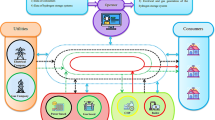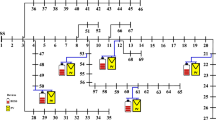Abstract
Installing remote terminal units (RTUs) in smart distribution grids enables the distribution system operator (DSO) and end-side customers to properly execute demand response programs (DRPs). Direct load control (DLC) refers to an incentive-based DRP, in which, DSO contracts with customers to control a specific percentage of their consumptions. In initial stages, the limited budget and technical hurdles avert the widespread deployment of RTUs in all buses. This issue instigates the need for an optimal placement of RTUs. Moreover, the existence of RTUs definitely affects the load shape of the network. Thus, the optimal placement strategy for distributed generations (DGs) should be revisited. To involve these issues together, an optimal two-stage multi-objective procedure is proposed which takes into account the simultaneous placement of DGs and RTUs. Different scenarios including variations in the number of DG units, DGs’ adaptive power factor (APF) for reactive power processes, and individual or simultaneous placement of DGs and RTUs are established and interrogated in depth. In numerical validations, both of the power losses minimization and voltage profile improvement are explored based on an AC power flow fashion optimized with genetic algorithm (GA). The extracted results are then transferred to the second stage which applies a multi-attribute decision making approach based on technique for order preference by similarity to ideal solution (TOPSIS). This stage considers the importance degrees or so-called weights for both of the objectives. In this way, the worth of each objective is suitably determined and involved in decision making process. Thus, the optimal placement strategy for simultaneous allocation of DGs and RTUs is determined.


















Similar content being viewed by others
Abbreviations
- \(i, \, j , { }\varOmega_{B} ,N_{B}\) :
-
Indices, set, and total number of buses
- \(k , { }\varOmega_{Br}\) :
-
Index and set of branches
- \(s , { }\varOmega_{S}\) :
-
Index and set of substations
- \(\varOmega_{i}\) :
-
Set of buses connected to bus i
- \(l,m\) :
-
Index and total number of alternatives
- \(u,n\) :
-
Index and total number of attributes
- R k :
-
Resistance of k-th branch
- Z ij :
-
Impedance of the branch between buses i and j
- \(S_{s}^{\hbox{max} }\) :
-
Maximum allowable apparent power that could be flowed through s-th substation
- \(S_{{_{k} }}^{\hbox{max} }\) :
-
Maximum allowable apparent power flowing each feeder
- \(P_{DG}^{\hbox{min} } , \, P_{DG}^{\hbox{max} }\) :
-
Minimum and maximum limits for DG’s active power
- \(Q_{DG}^{\hbox{min} } , \, Q_{DG}^{\hbox{max} }\) :
-
Minimum and maximum limits for DG’s reactive power
- \(S_{DG}^{\hbox{max} }\) :
-
Maximum limit for DG’s apparent power
- \(P_{L} ,Q_{L}\) :
-
Active and reactive powers at each bus
- \(Y_{ij} , \, \theta_{ij}\) :
-
Magnitude and phase angle of feeder’s admittance
- \(S_{L}^{{}}\) :
-
Apparent power of distribution feeders
- \(PF_{\text{DG}}^{ \hbox{min} } , \, PF_{\text{DG}}^{ \hbox{max} }\) :
-
Minimum and maximum values for DG’s power factor
- \(V_{\hbox{min} } , \, V_{\hbox{max} }\) :
-
Minimum and maximum limits of bus voltages
- I k :
-
Current magnitude in k-th branch
- \(N_{DG}\) :
-
Number of DGs to be installed
- \(N_{RTU}\) :
-
Number of RTUs to be installed
- \(PF_{L}\) :
-
Constant power factor of load at each bus subjected to be equipped with RTUs
- \(W_{u}\) :
-
Importance degree of each attribute
- P Loss :
-
Total power losses
- x, u :
-
Vector of dependent and independent variables
- V i :
-
Voltage at bus i
- I i :
-
Equivalent current at bus i
- B k :
-
Current at branch k
- \(P_{s} , \, Q_{s}\) :
-
Active and reactive power imported from s-th substation
- \(P_{DLC} , \, Q_{DLC}\) :
-
Active and reactive power reduction by DLC responsive load
- \(P_{k} , \, Q_{k}\) :
-
Active and reactive power flowing k-th branch
- \(P_{DG} , \, Q_{DG}\) :
-
Active and Reactive power generation by DG at bus i
- \(PF_{\text{DG}}^{{}}\) :
-
Power factor of DG
- \(a_{lu}\) :
-
Performance of l-th alternative regarding u-th attribute
- \(X_{u}^{ + }\) :
-
Ideal solution for each attribute
- \(X_{u}^{ - }\) :
-
Anti-Ideal solution for each attribute
- \(S_{l}^{ + }\) :
-
Distance of each alternative from ideal solution
- \(S_{l}^{ - }\) :
-
Distance of each alternative from anti-ideal solution
- \(C_{l}\) :
-
The mean distance of each alternative from anti-ideal solution
References
Ackermann T, Andersson G, Soder L (2001) Distributed generation: a definition. Electr Pow Syst Res 57:195–204. doi:10.1016/S0378-7796(01)00101-8
AlRashidi MR, AlHajri MF (2011) Optimal planning of multiple distributed generation sources in distribution networks: a new approach. Energ Convers Manage 52:3301–3308. doi:10.1016/j.enconman.2011.06.001
Baran ME, Wu FF (1989) Optimal capacitor placement on radial distribution systems. IEEE Trans Power Deliver 4:725–734. doi:10.1109/61.19265
Chiang HD, Jean Jumeau R (1990) Optimal network reconfigurations in distribution systems. II. Solution algorithms and numerical results. IEEE Trans Power Deliver 5:1568–1574. doi:10.1109/61.58002
El-Khattan W, Hegazy YG, Salama MMA (2005) An integrated distribution generation optimization model for distribution system planning. IEEE Trans Power Syst 20:1158–1165. doi:10.1109/TPWRS.2005.846114
Goldberg DE (1989) Genetic algorithms in search, optimization and machine learning. Addison-Wesley, Boston, USA
Golshannavaz S (2014) Optimal simultaneous siting and sizing of DGs and capacitors considering reconfiguration in smart automated distribution systems. J Intell Fuzzy Syst 27:1719–1729. doi:10.3233/IFS-141138
Han G, Xu B, Fan K, Lv G (2014) An open communication architecture for distribution automation based on IEC 61850. Int J Electr Power Energy Syst 54:315–324. doi:10.1016/j.ijepes.2013.07.013
Harrison GP, Piccolo A, Siano P, Wallace AR (2008) Hybrid GA and OPF evaluation of network capacity for distributed generation connections. Electr Pow Syst Res 78:392–398. doi:10.1016/j.epsr.2007.03.008
Hoke A, Butler R, Hambrick J, Kroposki B (2013) Steady-state analysis of maximum photovoltaic penetration levels on typical distribution feeders. IEEE Trans Sustain Energ 4:350–357. doi:10.1109/TSTE.2012.2225115
Hung DQ, Mithulananthan N (2013) Multiple distributed generator in primary distribution networks for loss reduction. IEEE Trans Ind Electron 60:1700–1708. doi:10.1109/TIE.2011.2112316
Hwang CL, Yoon K (1981) Multiple attribute decision making. Springer, Berlin
Kostkova K, Omelina L, Kycina P, Jamrich P (2013) An introduction to load management. Electr Pow Syst Res 95:184–191. doi:10.1016/j.epsr.2012.09.006
McDonald J (2008) Adaptive intelligent power systems: active distribution networks. Energ Policy 36:4346–4351. doi:10.1016/j.enpol.2008.09.038
Niknam T (2008) A new approach based on ant colony optimization for daily Volt/Var control in distribution networks considering distributed generators. Energ Convers Manage 49:3417–3424. doi:10.1016/j.enconman.2008.08.015
Niknam T, Bornapour M, Gheisari A (2013) Combined heat, power and hydrogen production optimal planning of fuel cell power plants in distribution networks. Energ Convers Manage 66:11–25. doi:10.1016/j.enconman.2012.08.016
Ochoa LF, Harrison GP (2011) Minimizing energy losses: optimal accommodation and smart operation of renewable distributed generation. IEEE Trans Power Syst 26:198–205. doi:10.1109/TPWRS.2010.2049036
Pilo F, Pisano G, Soma GG (2011) Optimal coordination of energy resources with a two-stage online active management. IEEE Trans Ind Electron 58:4526–4537. doi:10.1109/TIE.2011.2107717
Sedaghati R, Kavousi-Fard A (2014) A hybrid fuzzy-PEM stochastic framework to solve the optimal management of distribution feeder reconfiguration considering wind turbines. J Intell Fuzzy Syst 26:1711–1721. doi:10.3233/IFS-130850
Siano P (2014a) Assessing the impact of incentive regulation for innovation on RES integration. IEEE Trans Power Syst 29:2499–2508. doi:10.1109/TPWRS.2014.2304831
Siano P (2014b) Demand response and smart grids-A survey. Renew Sust Energ Rev 30:461–478. doi:10.1016/j.rser.2013.10.022
Siano P, Ochoa LF, Harrison GP, Piccolo A (2009) Assessing the strategic benefits of distributed generation ownership for DNOs. IET Gener Transm Distrib 3:225–236. doi:10.1049/iet-gtd:20080235
Soroudi A, Ehsan M (2012) Imperialist competition algorithm for distributed generation connections. IET Gener Transm Distrib 6:21–29. doi:10.1049/iet-gtd.2011.0190
Taherpoor H, Niknam T, Kavousi-Fard A (2015) A novel stochastic framework for energy management in renewable micro-grids considering uncertainty of measurement and forecasting. J Intell Fuzzy Syst 28:999–1008. doi:10.3233/IFS-141383
Teng JH (2003) A direct approach for distribution system load flow solutions. IEEE Trans Power Deliver 18:882–887. doi:10.1109/TPWRD.2003.813818
Zanakis SH, Solomon A, Wishart N, Dublish S (1998) Multi-attribute decision making: a simulation comparison of select methods. Eur J Oper Res 107:507–529. doi:10.1016/S0377-2217(97)00147-1
Zarea M, Niknam T, Azizipanah R, Amiri B (2014) Multi-objective probabilistic reactive power and voltage control with wind site correlations. Energ Convers Manage 66:810–822. doi:10.1016/j.energy.2014.01.034
Author information
Authors and Affiliations
Corresponding author
Rights and permissions
About this article
Cite this article
Sattarpour, T., Nazarpour, D., Golshannavaz, S. et al. A multi-objective hybrid GA and TOPSIS approach for sizing and siting of DG and RTU in smart distribution grids. J Ambient Intell Human Comput 9, 105–122 (2018). https://doi.org/10.1007/s12652-016-0418-8
Received:
Accepted:
Published:
Issue Date:
DOI: https://doi.org/10.1007/s12652-016-0418-8




